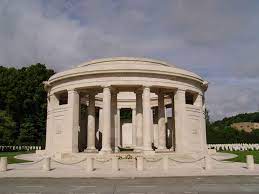Denis Wilfred Hunter
Date of birth: 1899
Date of death: 15.4.1918
Area: Brotherton
Regiment: Duke of Wellington’s (West Riding)
Family information: Son of Titus and Marion Hunter of Low Street, Brotherton
Rank: Private
Service number: 268982
War Service
Dennis enlisted in the Second Battalion of the Duke of Wellington (West Riding) Regiment The exact date of his enlistment is not clear, however, his medal entitlement gives some indication. He was certainly not in the ‘theatre of war’ until after the end of 1915 and, of course, there is his age. He would not have been 16 years old until the end of 1915. It is likely, therefore, that he joined up some time after this date. The 2nd Battalion had been in France since 1914 and at the beginning of 1916 they transferred to the 12th Brigade in the 4th Division who took part in much action.
1916
The Battle of Albert* (The details of this action are included in the account of James Gregg Hutchinson)
The Battle of Le Transloy* 1 -18 October
Heartened by the occupation of much of the Thiepval Ridge, Haig determined to continue large-scale offensive operations into the autumn. The Battle of the Transloy Ridges represented Fourth Army's part in this grand design, and its constituent costly attacks were intended to coincide with simultaneous advances by the Reserve Army planned for early October.
The fighting took place during worsening weather and dreadful battlefield conditions. Fourth Army's objectives necessitated, as a preliminary, the taking of Eaucourt L'Abbaye and an advance on III Corps entire front was launched, after a seven-hour bombardment, at 3.15pm on 1 October. The attack met fierce German resistance and it was not until the afternoon of 3 October that the objectives were secured. Rawlinson’s follow-up attack was delayed by atrocious weather. Starting at 1.45pm on 7 October the advance involved six divisions and resulted in heavy British casualties and little success except for 23rd Division's capture of Le Sars. Continuous rain during the night hampered the removal of casualties and further forward moves. The failure to secure original battle objectives led to a renewed major assault on the afternoon of 12 October when infantry on Fourth Army’s right floundered towards German trench lines in front of Le Transloy, while formations on the left slogged towards the Butte de Warlencourt. Despite the slightest of gains (measured in hard fought for trench yards) the operation was not successful.
Orders for a fresh attack, issued late on 13 October, ignored the desperate conditions and physical state of the attacking troops. The subsequent early morning assault on 18 October (well before daylight) witnessed heroic efforts to advance but minimal gains were made against resolute defenders well supported by accurate artillery fire.
The battles marked * are phases of the Battles of the Somme 1916
1917
The First Battle of the Scarpe**
The Third Battle of the Scarpe**
The battles marked ** are phases of the Battles of Arras 1917
The Battle of Polygon Wood***
The Battle of Broodseinde***
The Battle of Poelcapelle***
The First Battle of Passchendaele***
The battles marked *** are phases of the Third Battle of Ypres
1918
The First Battle of Arras 1918****
The battle marked **** is a phase of the First Battles of the Somme 1918
The Battle of Hazebrouck (a phase in the Battles of the Lys) in which the battalion fought in the Defence of Hinges Ridge.
The Battle of the Lys (also known as the Lys Offensive, the Fourth Battle of Ypres, the Third Battle of Flanders and as the Batalha de La Lys in Portugal) was part of the
1918 German offensive in Flanders during World War I (also known as the Spring Offensive), originally planned by General Ludendorff as Operation George but reduced to become Operation Georgette, with the objective of capturing Ypres and forcing the British forces back to the Channel ports (and thereby forcing Britain out of the war). Starting on 9th April 1918 the battle lasted until 29th April. The Battle of Hazebrouck took place between 12th – 15th April.
Family Life
Dennis Hunter’s ancestors can be traced back to the beginning of the 1800’s to James Hunter. The Brotherton connection, however, was through James’s wife
Sarah Richardson. Dennis’s father was Titus who married Marion Taylor (born in
Leeds) in Goole in 1898.
By 1901 they were living in Bramham’s Row and had one son – Denis Wilfred aged 3. Titus was employed as a ‘coalminer - hewer’.
The next 10 years to 1911 saw a few changes including the birth of Cyril Arthur in late 1901 and a change of employment for Titus who was an ‘assurance agent’. The family later moved to Low Street.
 Ploegsteert Memorial
Ploegsteert Memorial

